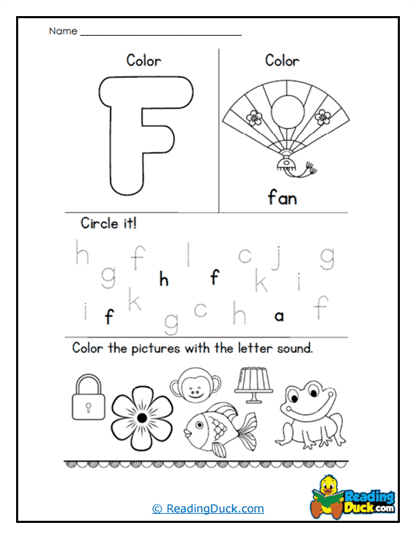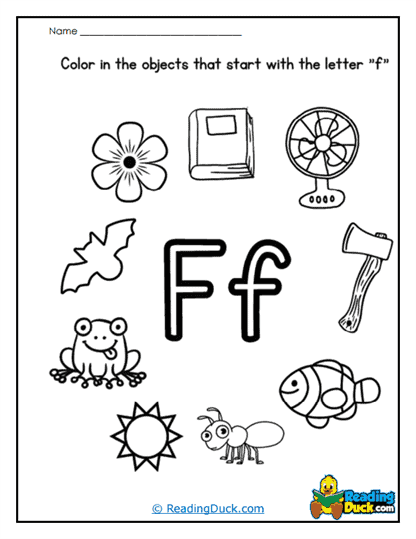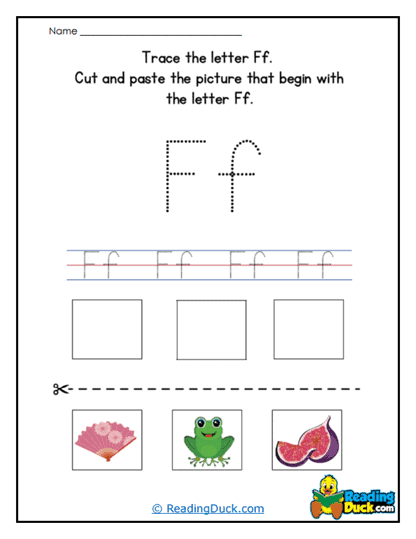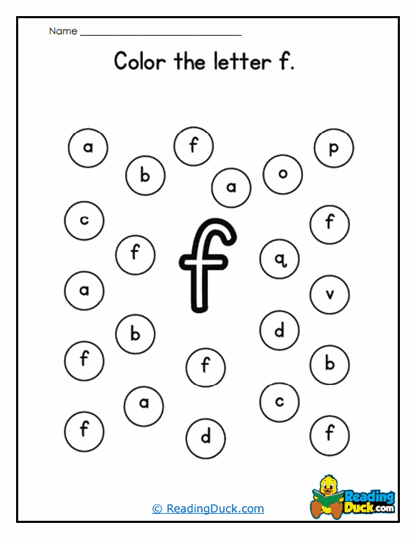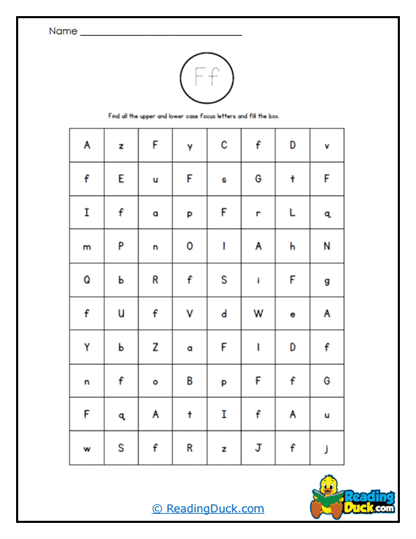Letter F Worksheets
About Our Letter F Worksheets
All worksheets in this collection contain Letter F worksheets that are visually engaging for young students. This collection includes various activities designed to improve young learners’ familiarity with the letter F, focusing on both reading/recognizing and writing it. These worksheets are all readily available in PDF files, making them easy to view electronically, download, and print out for usage. Each worksheet set comes with an answer key to support teachers and parents.
Understanding the Letter F: A Building Block for Early Literacy
The letter F plays an essential role in the early stages of literacy development. As one of the key consonants in the English alphabet, students must become familiar with this letter early on. When presenting the letter F to students, it is important to explore its many facets, from how it looks and sounds to how it functions in different words.
Key elements of the letter F to emphasize include:
- Alphabet Positioning and Importance: The letter F is the sixth letter in the alphabet. Teaching students where F fits into the alphabetical sequence helps develop their understanding of the broader structure of language. The frequent use of F in everyday words makes it a fundamental letter to master early in the literacy process.
- Phonetic Sound: The letter F typically represents a /f/ sound, as in “fish” or “fun.” Helping students recognize and reproduce this sound strengthens their phonemic awareness, which is a crucial step in learning to read. Introducing the sound through playful, memorable examples can help solidify students’ understanding.
- Visual Recognition: Being able to differentiate the letter F from other letters is a critical early literacy skill. Presenting F in both uppercase and lowercase forms (F and f) ensures that students can recognize the letter in various contexts. Teachers should incorporate opportunities for students to see the letter F in a variety of fonts and styles.
- Writing Practice: Students should practice writing both the uppercase and lowercase versions of the letter F. It’s important to emphasize the correct stroke order and letter formation, as this will help students develop their handwriting skills while reinforcing their familiarity with the letter.
- Vocabulary Building: Associating the letter F with commonly known words expands students’ vocabularies. Words like “frog,” “family,” and “flower” offer fun and relevant examples for young learners to grasp the letter F in context. Introducing real-world objects and images tied to these words deepens students’ engagement.
- Integration with Stories and Songs: Engaging students with stories, songs, and rhymes that feature words beginning with the letter F makes learning fun and interactive. This approach connects phonics and literacy with enjoyable activities that stimulate students’ imaginations.
- Interactive Learning: Incorporating interactive elements, such as tracing the letter F in the air or on paper, and playing games where students search for items starting with F in their environment, brings the learning experience to life. These hands-on experiences enhance retention and help students see the real-world relevance of learning the letter F.
By exploring the different elements that make up the letter F, teachers can provide students with a well-rounded understanding of its role in language and literacy.
Tips and Ideas for Integrating Letter F Worksheets into the Curriculum
Creative Ways to Incorporate Letter F Worksheets in Classroom or Homeschool Settings
Letter F worksheets can be an effective tool for teachers and parents to reinforce literacy concepts. Here are some creative and practical ways to integrate these worksheets into daily instruction and activities:
- Morning Letter Warm-Up: Start the day with a quick review of the letter F by displaying the letter prominently in the classroom. Students can work on a worksheet as part of their morning routine, practicing recognition and writing before transitioning into other subjects.
- Letter of the Week Theme: Dedicate a full week to exploring the letter F. Each day can focus on different aspects of the letter, such as its sound, how to write it, and words associated with it. The worksheets can be used to provide structured practice for students as they dive deeper into understanding the letter.
- Storytime Connection: Choose a book that emphasizes the letter F, such as “Five Little Frogs” or “Frank the Farmer.” After reading, have students complete a worksheet that ties into the story. This activity links literacy to storytelling and helps students connect the sound and shape of the letter to real-world contexts.
- Letter F Treasure Hunt: Create a classroom scavenger hunt where students search for objects that begin with the letter F, like “fork,” “fan,” and “feather.” After the hunt, they can complete a worksheet reinforcing what they found and writing down words associated with the letter F.
- Alphabet Crafts: Engage students in a craft project where they create the letter F out of fun materials like foam, fabric, or even finger paints. This hands-on project can be paired with a worksheet to reinforce letter formation and vocabulary.
- Group Learning Centers: Set up a letter F learning station where students rotate through different activities related to the letter. One center might involve tracing the letter on a worksheet, while another center could feature a matching game where students match pictures with words starting with F.
- Homework Assignments: Use Letter F worksheets as part of a homework assignment to extend learning beyond the classroom. Parents can engage with their children, reviewing the letter F and supporting their practice at home.
- Cross-Curricular Activities: Link the study of the letter F with other subjects. For instance, in science, students can learn about frogs and fill out a worksheet where they trace and write words related to frogs. In art, students can draw or paint objects starting with the letter F and label them.
- Interactive Digital Learning: If technology is available, consider using digital formats of the Letter F worksheets. Display them on an interactive whiteboard or use a tablet app where students can trace the letter with their finger or stylus, adding a tech-savvy twist to traditional learning.
- Assessment Tool: Use the worksheets as a formative assessment to gauge students' understanding of the letter F. Review their completed worksheets and provide feedback, helping them improve and grow in their literacy journey.
Grade Levels Benefiting from Letter F Worksheets
These worksheets are ideal for Pre-Kindergarten, Kindergarten, and early First Grade students. The worksheets can help early learners recognize, read, and write the letter F, supporting foundational literacy skills. English Language Learners (ELL) in early education may also benefit greatly from these worksheets as they build their English literacy. These activities are particularly useful for children who are just beginning to explore the alphabet and need to strengthen their understanding of individual letters.
Developing Skills through Letter F Worksheets
Building Essential Skills through Letter F Activities
The Letter F worksheets offer more than just letter recognition and writing practice; they also support the development of a wide range of academic and personal skills:
- Fine Motor Development: Tracing and writing the letter F helps improve fine motor skills. These worksheets encourage students to practice their handwriting, which strengthens hand muscles and improves coordination. These skills are essential for everyday tasks such as cutting, drawing, and more.
- Phonemic Awareness: Recognizing and producing the sound associated with the letter F strengthens phonemic awareness. This skill is foundational for decoding and reading new words, as students begin to associate the written letter with its corresponding sound.
- Cognitive Growth: Completing worksheets that involve recognizing, tracing, and writing the letter F requires focus, concentration, and problem-solving. Students develop cognitive skills by learning to follow instructions, identify patterns, and distinguish the letter F from other letters.
- Language and Literacy Development: Learning the letter F enhances students' understanding of the alphabet, helping them develop essential literacy skills such as reading, spelling, and vocabulary building. These skills are critical as students progress through their academic journey.
- Confidence and Independence: As students work through the Letter F worksheets and successfully complete tasks, they gain a sense of accomplishment. This confidence helps build independence and motivates them to tackle more challenging literacy tasks in the future.
- Creativity and Expression: While practicing with the letter F, students can also engage in creative activities, such as drawing pictures of objects that start with F. This allows them to express themselves creatively while reinforcing their literacy skills.
- Social and Collaborative Skills: Group activities related to the letter F encourage collaboration and communication among peers. Working together on tasks fosters a sense of teamwork and builds social skills, which are essential for both academic success and personal development.
By integrating these worksheets into the classroom or home environment, students can develop not only their literacy skills but also a wide range of cognitive, motor, and social abilities. These foundational skills are crucial for their ongoing academic growth and success.
The Importance of Learning the Letter F
Why Mastering the Letter F is Crucial for Early Literacy
Mastering the letter F is a key step in a child’s early literacy education. Through the use of Letter F worksheets, students gain the ability to recognize, read, and write this essential consonant while developing important foundational skills. These worksheets not only reinforce early literacy but also provide an engaging way for students to explore the alphabet. By building a strong understanding of the letter F, students are setting themselves up for success in reading, writing, and overall academic achievement.
